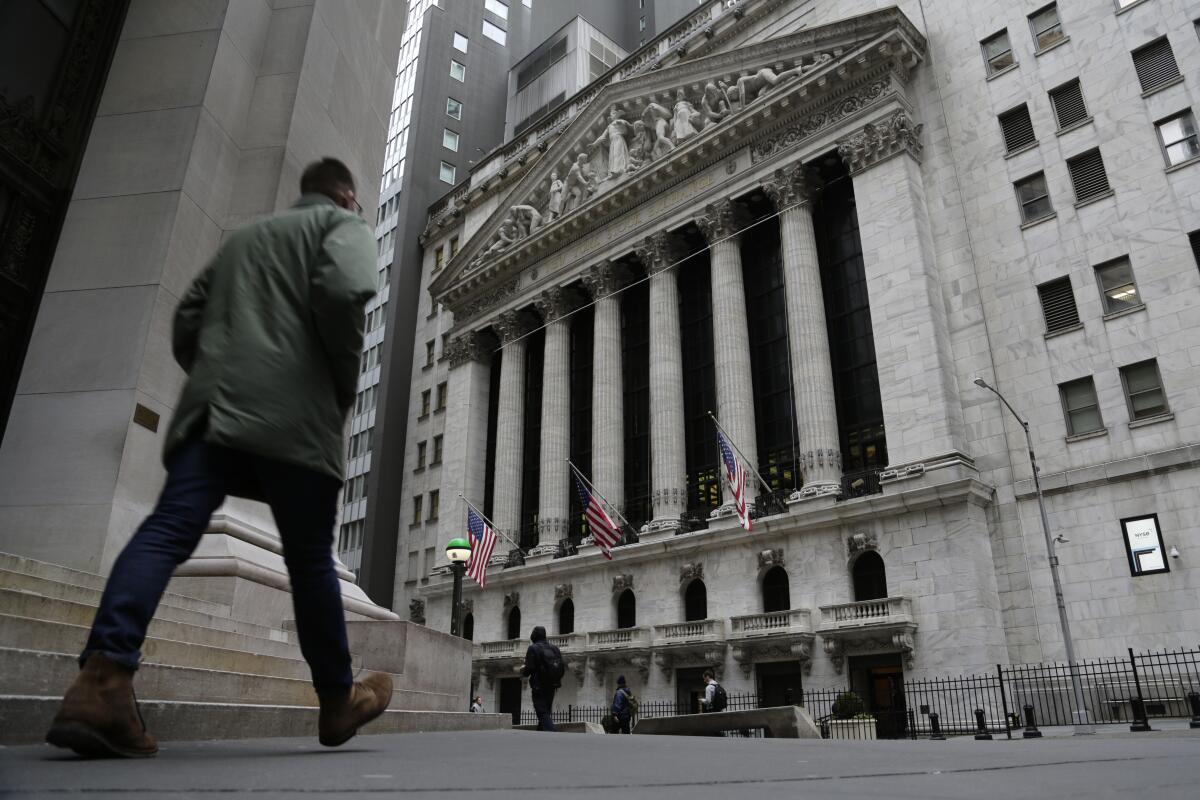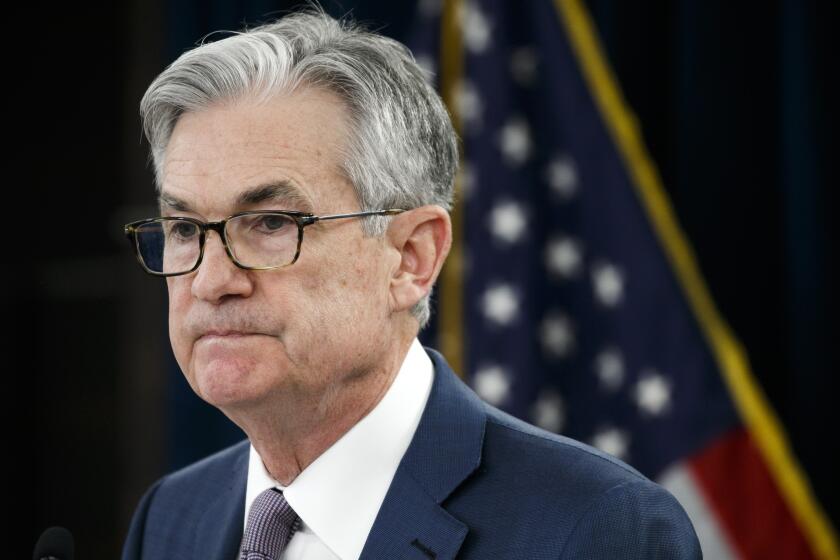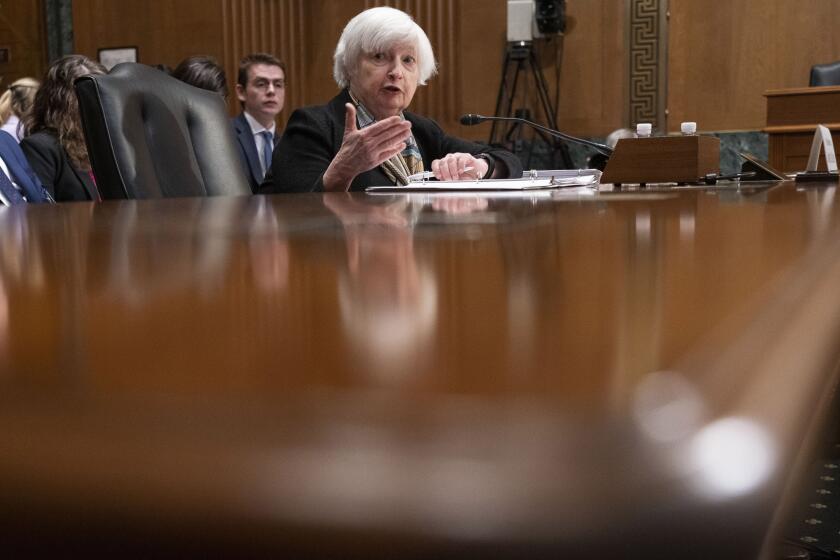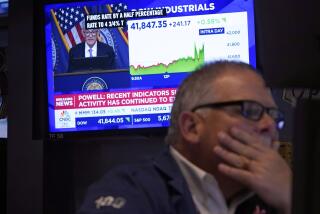Stocks fall, bond yields tumble after Fed’s latest rate hike

- Share via
Stocks fell sharply Wednesday after the Federal Reserve indicated that the end may be near for its economy-crunching hikes to interest rates but also said it doesn’t expect to cut rates anytime soon despite Wall Street’s hopes.
The Standard & Poor’s 500 index fell 1.6% for its first drop in three days. The Dow Jones industrial average lost 1.6%, while the Nasdaq composite dropped 1.6%.
Some of the sharpest drops came again from the banking industry, where investors are worried about the possibility of customers yanking their cash to cause more collapses. They slid after Treasury Secretary Janet L. Yellen said she’s not considering blanket protection for all depositors at all banks, unless they present a risk to the overall system.
Stocks had been little changed for much of the day, before the Fed raised its key rate by a quarter of a percentage point in its campaign to drive down inflation. The move was exactly what Wall Street was expecting. The bigger question was where the Fed is heading next. There, the Fed gave a hint that it may not hike rates much more as it assesses the fallout from the banking industry’s crisis.
Instead of repeating its statement that “ongoing increases will be appropriate,” the Fed said Wednesday that it now only sees “some additional policy firming may be appropriate.” Chair Jerome H. Powell emphasized the shift to ”may” from “will.”
The Fed also released the latest set of projections from its policymakers on where rates are heading in upcoming years. The median forecast had the federal funds rate sitting at 5.1% at the end of this year, up only a smidge from where it currently sits, in a range of 4.75% to 5%.
The Fed missed last year’s inflation spike. Its actions since then have sown havoc in the banking sector and now threaten the whole economy.
That’s also the same level as seen in December, and it’s counter to worries in the market that it could rise, given how stubborn high inflation has remained.
That helped to send yields slumping in the bond market, which has been home to some of the wildest action this month.
The yield on the two-year Treasury, which tends to track expectations for the Fed, tumbled to 3.96% from 4.13% just before the projections were released. It was above 5% early this month.
Some of this month’s slide also came from building hopes for rate cuts later this year by the Fed. Such cuts can boost prices for stocks, bonds and other investments while giving the economy more room to breathe. They also, though, can give inflation more fuel.
Powell said Wednesday that the Fed is still focused on getting inflation down to its 2% goal and that it is not envisioning any rate cuts this year. He also said the Fed could begin raising rates again, even after it takes a pause, if high inflation makes that necessary. That took some momentum out of the market.
Economic “indicators are still pretty resilient,” said Sameer Samana, senior global market strategist at Wells Fargo Investment Institute. “For markets to still speculate on rate cuts, it’s probably not going to take place this year if the Fed has its way.
Janet L. Yellen addresses an American Bankers Assn. conference after the collapses of Silicon Valley Bank and Signature Bank.
“There were a good dozen or so instances where he kept bringing it back to inflation. For better or worse, he was pretty consistent.”
The Fed was stuck with a difficult decision as it balanced whether to keep hiking rates to drive down inflation or to ease off the increases given the pain it’s already caused for the banking industry, which could drag down the rest of the economy. The second- and third-largest U.S. bank failures in history have occurred in the last two weeks.
A worry is that too much pressure on the banking system, particularly among the smaller and midsize banks in investors’ crosshairs, would mean fewer loans to businesses across the country. That in turn could mean less hiring and less economic activity, raising the risk of a recession that many economists already see as high.
Powell said such a pullback in lending could act almost like a rate hike on its own. And that was one of the reasons the Fed opted to raise its key rate by only 0.25 points Wednesday instead of 0.50 points. He also said that he sees the banking system overall as strong and sound.
Markets around the world have pinballed sharply this month on worries that the banking system may be cracking under the pressure of much higher rates. They found some strength recently after Yellen indicated on Tuesday that the government may back depositors at more weakened banks if the system is at risk.
Financial turmoil has some people wondering if a systemic problem is putting all banks in peril, as in the Great Recession. Experts say that isn’t the case.
That could mean making sure even customers with more than the $250,000 limit insured by the Federal Deposit Insurance Corp. can get all their money. On Wednesday, though, Yellen said that she wasn’t considering blanket protections for all depositors at all banks, only for those “when it’s deemed to be a systemic risk.”
Stocks of smaller and midsize banks fell sharply. First Republic Bank dropped 15.5%, and PacWest Bancorp fell 17.1%.
Some of the biggest excitement was around what are called “meme stocks.”
GameStop shot up 35.2% after it reported a surprise profit for its latest quarter. Analysts were expecting another loss for the struggling video-game retailer.
The stock rocked Wall Street in early 2021 when hordes of small investors and novices piled into it, sending its price surging and inflicting big losses on hedge funds that had bet on its decline.
All told, the S&P 500 fell 65.90 points to 3,936.97. The Dow dropped 530.49 points to 32,030.11, and the Nasdaq fell 190.15 points to 11,669.96.
AP writers Elaine Kurtenbach, Matt Ott and Fatima Hussein contributed to this report.
More to Read
Inside the business of entertainment
The Wide Shot brings you news, analysis and insights on everything from streaming wars to production — and what it all means for the future.
You may occasionally receive promotional content from the Los Angeles Times.













